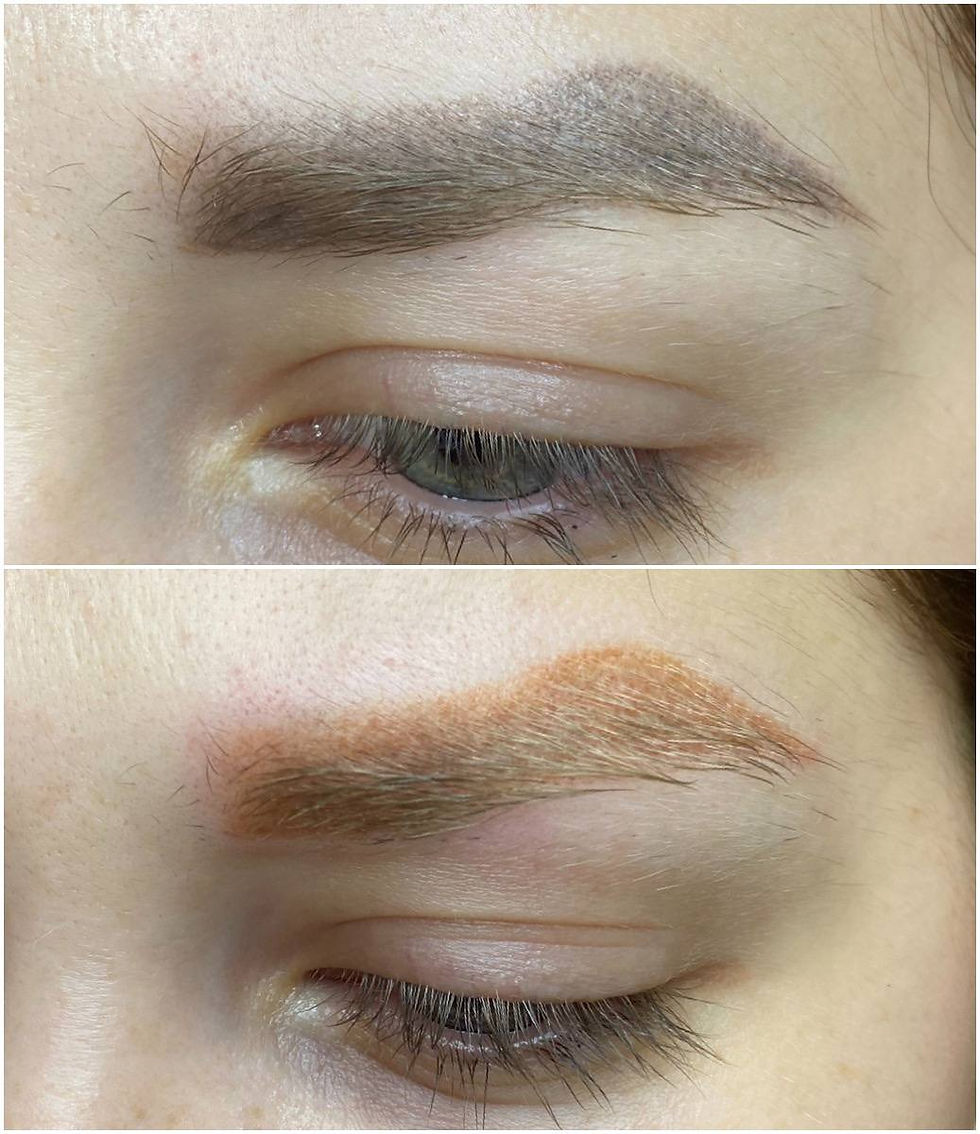Warmth Fades Away: The Second Reason Why Permanent Makeup Eyebrow Pigments Change Color
- Julia Rozgon
- Jun 22, 2025
- 3 min read

In the first article, we explained how carbon black—the most stable black component commonly used in permanent eyebrow pigments—affects the healed result.
It’s often responsible for the grayish hue that appears when other components in the formula fade away.
But that’s only half the story.
Today, we focus on another key factor—often overlooked even by experienced PMU artists: yellow pigment. This component plays a crucial role in maintaining warmth in eyebrow shades.
What Are Permanent Makeup Eyebrow Pigments Made Of?
A brown pigment is not a single color. It’s a blend of multiple pigments, carefully balanced to achieve the desired tone in permanent makeup formulas. Typically, the structure looks like this:
1 part black — usually carbon black or iron oxide black (CI 77499);
2–3 parts red — vibrant organic dyes or muted inorganic oxides;
3 or more parts yellow — ranging from bright organics to subdued inorganics.
In some formulations, orange pigment is used as an alternative to the red+yellow blend—or simply as an additive to increase warmth.
It’s the yellow pigment that softens the coolness of black and balances the intensity of red, creating a natural, harmonious brown shade.
Why Yellow Is the Weakest Link in Eyebrow Pigments
Among all ingredients in a permanent eyebrow pigment, yellow is the least stable. Organic yellow and orange pigments (e.g., CI 11741, CI 21095) widely used in PMU inks:
Have complex molecular structures with double bonds;
Break down under UV exposure, oxidation, and skin’s biochemical processes.
Inorganic yellow iron oxide (CI 77492) is more lightfast but still not as stable as black—especially carbon black.
There is no standalone inorganic orange pigment—it’s always a mixture of red and yellow oxides.
Lighter brown and hazelnut tones containing more inorganic yellow retain their warmth better. But in darker or more saturated browns, yellow fades over time, leading to cooler healed results.
What Happens When the Yellow Pigment Disappears?
When yellow fades from the formula, the entire color balance is thrown off:
Black becomes dominant → leading to a cooler, more ashy result;
Red + black without yellow → often turns into a purplish undertone;
Final result: gray-blue, dusty burgundy, or even violet shades.
Despite chemical efforts, yellow pigment remains hard to stabilize long-term. Simply adding more yellow is not a solution—this would make brow shades too light and unnatural.
Why Do Yellow Stains Remain After Laser Removal?
Laser removal specialists often observe this phenomenon:
Some dark, cool-toned PMU pigments turn orange and then yellow after several laser sessions.
Why does this happen?

Black (carbon or iron oxide) is removed effectively.
Red takes a bit longer to fade.
Yellow, previously invisible, suddenly becomes visible.
Organic yellow pigment does not absorb laser energy at 1064 nm or 532 nm. It remains in the skin even after multiple removal sessions and is extremely resistant to laser treatment.
On the other hand, inorganic yellow (CI 77492):
responds well to laser energy;
breaks down under laser pulse;
does not leave yellow stains after removal.

In such cases, the issue isn’t the laser — it’s the organic yellow pigment that remains, while the other colors have already faded.
How is this addressed in WizArt pigments?
At WizArt, we have been focused from the beginning on optimizing eyebrow pigments for permanent makeup:
In both the MAIN and CLASSIC pigment series, we use inorganic yellow iron oxide (CI 77492);
It is light-stable and does not trigger unexpected color shifts over time;
And if needed — it can be easily removed with a laser.
We have also developed a yellow corrector based on the same stable pigment — designed to neutralize cool residues or adjust pigment formulas as needed.
This solution helps maintain warmth in the pigment composition and prevents grayish tones in eyebrow permanent makeup — even years after the procedure.
✅ Conclusion
Yellow pigment often remains invisible — until it fades. And when it does, the warmth disappears from the eyebrow tattoo, leaving a result that may look very different from the original design.
Understanding the chemical nature of pigments is essential to a professional approach. It allows PMU artists to work not only with color in the present moment but also to predict long-term healed results — months or even years after the procedure.







Comments